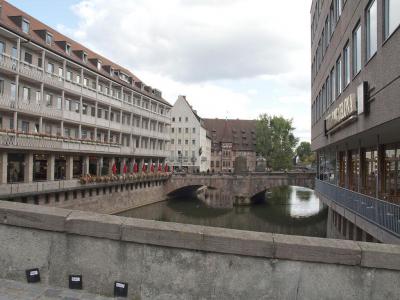
Museum Bridge, Nuremberg
The Museum Bridge in Nuremberg serves as a historical and architectural marvel, linking the districts of Saint Lorenz and Saint Sebald. This vital crossing over the Pegnitz River is located at the commencement of King Street (Königstrasse), strategically placed between the main market and Lorenzer Square. Known as Nuremberg’s oldest bridge, the site has hosted a bridge since the 13th century, originally documented as a wooden structure connecting the Franciscan monastery to the city, and initially named the Barefoot Bridge (Barfüßerbrücke).
The bridge's history is marked by frequent reconstructions due to natural disasters. Initially built with stone substructures and a wooden superstructure in 1484, it faced severe damage by floods in 1590, leading to its eventual reconstruction into a fully stone bridge in 1700. This construction featured two stone arch openings and was adorned with baroque pulpit-like structures with wrought-iron grilles, prominently displaying the coats of arms of the city government members of the era.
Throughout its history, the bridge underwent several name changes, reflecting shifts in its surrounding cultural and societal landscape. It was known as Joseph's Bridge (Josephsbrücke) or Royal Bridge (Königsbrücke) in the early 18th century, named after King Joseph I. By the 19th century, its proximity to the Company Museum (Gesellschaft Museum), a society for reading and gathering, led to its current name, Museum Bridge.
The bridge's significance extends beyond its functionality; it is a testament to the resilience and evolving architectural tastes of Nuremberg over the centuries. Rebuilt and widened in 1956 after destruction in the Second World War, the current sandstone arch bridge not only facilitates traffic but also stands as a monument to the city's rich historical heritage.
The bridge's history is marked by frequent reconstructions due to natural disasters. Initially built with stone substructures and a wooden superstructure in 1484, it faced severe damage by floods in 1590, leading to its eventual reconstruction into a fully stone bridge in 1700. This construction featured two stone arch openings and was adorned with baroque pulpit-like structures with wrought-iron grilles, prominently displaying the coats of arms of the city government members of the era.
Throughout its history, the bridge underwent several name changes, reflecting shifts in its surrounding cultural and societal landscape. It was known as Joseph's Bridge (Josephsbrücke) or Royal Bridge (Königsbrücke) in the early 18th century, named after King Joseph I. By the 19th century, its proximity to the Company Museum (Gesellschaft Museum), a society for reading and gathering, led to its current name, Museum Bridge.
The bridge's significance extends beyond its functionality; it is a testament to the resilience and evolving architectural tastes of Nuremberg over the centuries. Rebuilt and widened in 1956 after destruction in the Second World War, the current sandstone arch bridge not only facilitates traffic but also stands as a monument to the city's rich historical heritage.
Want to visit this sight? Check out these Self-Guided Walking Tours in Nuremberg. Alternatively, you can download the mobile app "GPSmyCity: Walks in 1K+ Cities" from Apple App Store or Google Play Store. The app turns your mobile device to a personal tour guide and it works offline, so no data plan is needed when traveling abroad.
Museum Bridge on Map






Sight Name: Museum Bridge
Sight Location: Nuremberg, Germany (See walking tours in Nuremberg)
Sight Type: Attraction/Landmark
Sight Location: Nuremberg, Germany (See walking tours in Nuremberg)
Sight Type: Attraction/Landmark
Walking Tours in Nuremberg, Germany
Create Your Own Walk in Nuremberg
Creating your own self-guided walk in Nuremberg is easy and fun. Choose the city attractions that you want to see and a walk route map will be created just for you. You can even set your hotel as the start point of the walk.
Nuremberg Old Town Walking Tour
The historical center of Nuremberg, Old Town (German: Altstadt) is easily differentiated from other parts of the city. Divided in two by the Pegnitz River, the district represents a complex architectural ensemble with a maze of historical lanes (e.g. Weissgerbergasse) packed with half-timber houses, linked by centuries-old bridges, such as Maxbrücke, and set against the picturesque backdrops of... view more
Tour Duration: 3 Hour(s)
Travel Distance: 3.8 Km or 2.4 Miles
Tour Duration: 3 Hour(s)
Travel Distance: 3.8 Km or 2.4 Miles
Hitler's Nuremberg Tour
Despite Nuremberg's storybook appearance, the city's not so distant past is rather dark. Back in 1933, amid the rise of the Third Reich, the Nazis worked really hard to leave their stamp on the city, prettifying it and renovating the architecture in a bid to accommodate their massive rallies and bombastic military parades.
In fact, no other city in Germany is more intertwined with the... view more
Tour Duration: 2 Hour(s)
Travel Distance: 4.9 Km or 3 Miles
In fact, no other city in Germany is more intertwined with the... view more
Tour Duration: 2 Hour(s)
Travel Distance: 4.9 Km or 3 Miles
Nuremberg Introduction Walking Tour
The most "German" of all cities in Germany, Nuremberg has witnessed many historic events in its lifetime. Sadly, the first thing immediately associated with Nuremberg is the rise of the Third Reich, the Nazi rallies, and the postwar trials over the Nazi leaders. Indeed, the city was favored by Hitler, who planned to build here a grandiose architectural complex for his party.
... view more
Tour Duration: 2 Hour(s)
Travel Distance: 2.8 Km or 1.7 Miles
... view more
Tour Duration: 2 Hour(s)
Travel Distance: 2.8 Km or 1.7 Miles



